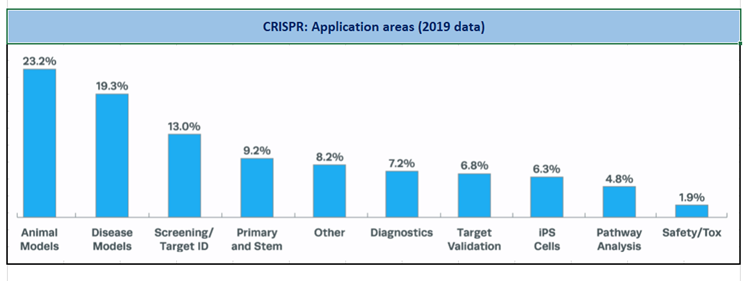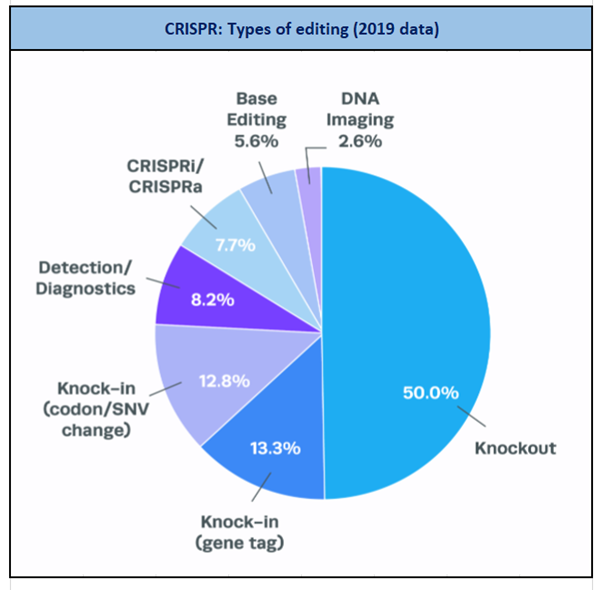Executive Summary
Programming gene expression is a crucial step in understanding genetic diseases and developing therapeutics. Unfortunately, because of the varying efficiencies of targeting, researchers don’t know which guide RNA to use for any particular gene of interest without the expensive process of testing in live cells. Research institutions spend a lot of time and money on this process. We need a software algorithm to optimize functional protein knockout and minimize off-target editing. With better guide RNA prediction software, this time, money and resource-intensive process can be streamlined.
Our value proposition
Using AI and machine learning, we can predict guide RNAs for somatic gene editing more quickly, cheaply, and accurately than existing technology can. A typical gene editing project can cost nearly $50K, taking nearly a month for the knockdown of one gene. We would like to position ourselves to support labs and corporate clients, for whom saving time and money are competitively essential. Our flagship product is Odigos, a software tool providing better prediction of guide RNA effectiveness using machine learning and AI algorithms. We also want to position ourselves ethically to avoid clients doing germline gene editing.
Market analysis
1. Industry outlook
The global market size of CRISPR technology was USD 1.67 Billion in 2020, expected to nearly triple by 2027. North America dominated the market with a 38% share in 2019. Biotechnology and pharmaceutical companies segment account for the largest market share of 52% in 2020.2. Survey data
CRISPR application areas:Primarily, CRISPR technology is used in animal models and disease models and diagnostics.

Fig-2: CRISPR application areas survey data

Fig-3: CRISPR types of editing survey data
Market Positioning
Odigos software would be mainly marketed towards academic and institutional clients, predicted to be the fastest growing part of the market by CAGR. Particularly in academia, these clients feature researchers who are working on a project during the term of a short assignment, Ph.D. research, or Post Doc. Alternately, in industry, companies are competing with each other to beat other firms to market with cutting-edge technology. Speeding up their timeline for research will allow valuable research advancements with more efficient genome editing. Odigos can market itself as an essential tool cutting project timelines for both deadline-pressed academics and companies eager to get to market with their new products.
The business model
1. Customer segments
Odigos helps many stakeholders in the biotechnology ecosystem by streamlining time, money, and effort. A few of our target customer segments would be:- Academic & Government Research Institutes; currently, MIT holds largest number of relevant patents
- Scientific communities
- Private Research labs
- Other CRISPR-centric companies, leveraging our software’s power through technology partnerships
- Agriculture
2. Target application segments

Fig-4: CRISPR research areas survey data
- Reversing the mutation of cancer cells
- Cell and gene therapy
- Therapeutics
- agriculture (enhancing crops or preventing and treating animal disease)
3. Growth model
CRISPR technology is still in a nascent stage and we would like to explore & establish strategic partnerships with the below entities to grow together.- Investors
- Technology partners
- Community experts
- Contract research organizations
4. Revenue sources
Odigos is a cloud-based software tool. Like any B2B SaaS product, we are planning to make the tool accessible through an annual/monthly subscription-based revenue model with inclusive innovation.- Profit margins on base subscriptions & add-ons.
- Fees from companies/others that would like to use our tool’s capabilities through APIs
- Partnership sales
- Licensed use of algorithm
Target Customer
Odigos can solicit academic and corporate partnerships through the network of academic and corporate clients of UCSF Gladstone Institutes. UCSF Gladstone Institutes is a renowned lab given the profile of Nobel Prizewinners Shinya Yamanaka and Jennifer Doudna, a lab where some Odigos team members have worked and where CRISPR was founded. Technologies associated with UCSF Gladstone would clearly be desirable to others seeking to lead in the field.
Competitors

Table-1: Competitors list
Stakeholder Analysis
Academic Labs - Academic labs would be a tremendous beneficiary of our software, cutting R&D time on important projects, and providing a cutting edge in the race to discover, publish, and patent new findings.
Biotech firms - Biotech firms would have a competitive advantage by using our product by cutting their R&D expenses and timeline. For any business, cost-cutting measures are an essential part of protecting profits. Furthermore, streamlining the developmental timeline could help participating firms become more competitive in their sector of the industry.
Software Companies - Software companies could be excellent collaborators in the effort to find AI and ML solutions to genomic sequencing challenges. By licensing our technology, other software companies could continue to improve on our algorithm to pursue further advancements for lab research.
Investors - Investors have a unique opportunity by helping us patent and market our software. Investors may have the potential to profit from our venture, including from IP royalties that accrue over time.
The Chronically Ill -- Fundamentally, the most important stakeholder is the end user of the biomedical research that would be executed more quickly and cost-effectively. By cutting the timeline during important phases of research, as well as by making research a more cost-effective process, labs and private companies could make new discoveries more quickly, ultimately leading to more therapeutics available to patients more quickly. For seriously ill patients, such advances could lengthen enjoyable lifespan or increase the quality of life for people who otherwise would suffer more severely from their illnesses.
Biotech firms - Biotech firms would have a competitive advantage by using our product by cutting their R&D expenses and timeline. For any business, cost-cutting measures are an essential part of protecting profits. Furthermore, streamlining the developmental timeline could help participating firms become more competitive in their sector of the industry.
Software Companies - Software companies could be excellent collaborators in the effort to find AI and ML solutions to genomic sequencing challenges. By licensing our technology, other software companies could continue to improve on our algorithm to pursue further advancements for lab research.
Investors - Investors have a unique opportunity by helping us patent and market our software. Investors may have the potential to profit from our venture, including from IP royalties that accrue over time.
The Chronically Ill -- Fundamentally, the most important stakeholder is the end user of the biomedical research that would be executed more quickly and cost-effectively. By cutting the timeline during important phases of research, as well as by making research a more cost-effective process, labs and private companies could make new discoveries more quickly, ultimately leading to more therapeutics available to patients more quickly. For seriously ill patients, such advances could lengthen enjoyable lifespan or increase the quality of life for people who otherwise would suffer more severely from their illnesses.
Intellectual Property
Although we are making the software open source, we plan to secure a patent for our algorithm for future use. We have many other ideas outside of iGEM that we believe will give us an advantage in this competitive landscape.
Risk Analysis
Legal - CRISPR could be misused by end consumers for unethical or illegal purposes
Business - Initial outlay of funds to secure Intellectual Property protection, as well as need to keep re-developing algorithm to stay ahead of competitors
Systemic Risks - if human stem cell research is ever outlawed, that ban would present substantial hardship, although work with animal stem cells could continue
Systemic Risks - if human stem cell research is ever outlawed, that ban would present substantial hardship, although work with animal stem cells could continue
Sources:
- https://www.aheadintel.com/crispr-cas9-market-report-infographics/
- https://www.grandviewresearch.com/industry-analysis/crispr-associated-cas-genes-market
- https://app.hubspot.com/documents/2418554/view/80938056?accessId=d95892
- https://www.medicalstartups.org/top/crispr/
- Teece, D.J. (1986). Profiting from Technological Innovation: Implications for integration, collaboration, licensing and public policy. Research Polity, 15(6), 285- 306.

